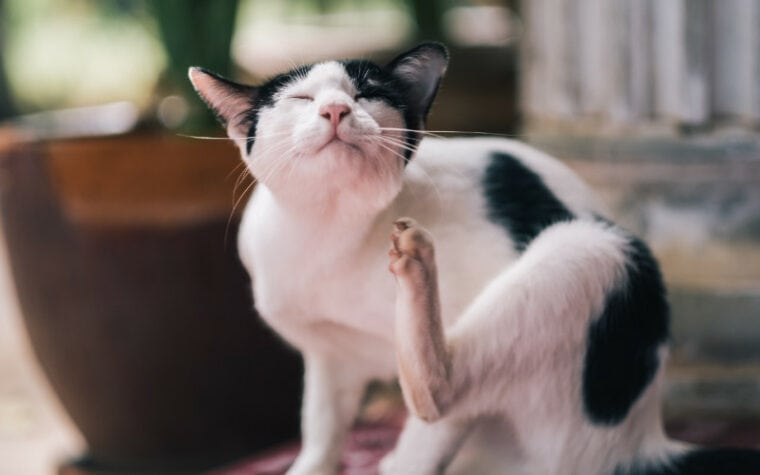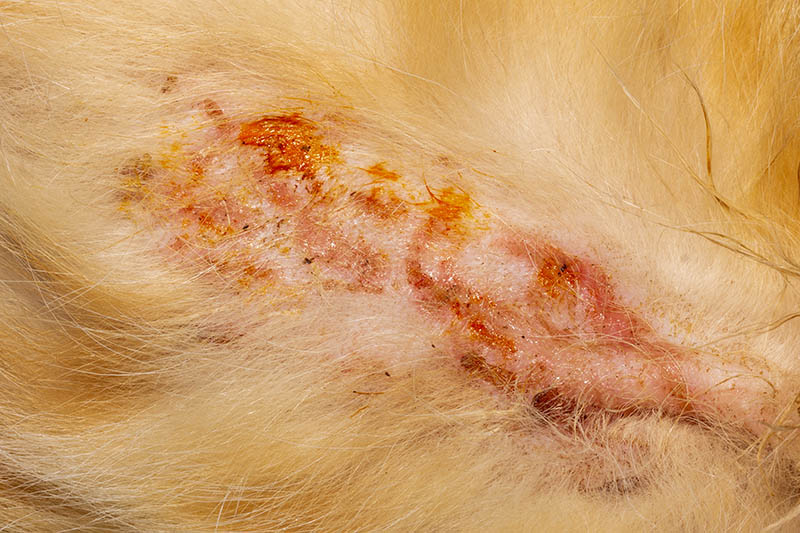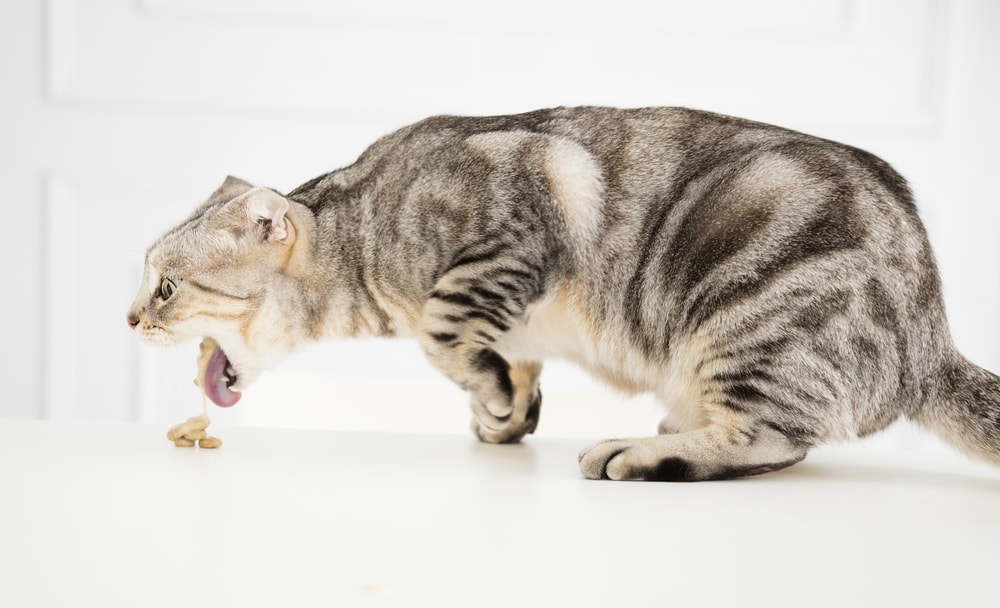
If you’ve got an allergy to anything, you know how serious it can be. Even a little bit of an allergen (a substance that causes an allergic reaction) in your diet can make you sick. And that’s true for cats, too—just like humans, they can have mild to severe allergic reactions to certain ingredients in their food.
Feline atopic syndrome (FAS) is a newly coined veterinary term that encompasses a variety of allergic diseases, including allergic skin disease, digestive disease, and respiratory disease (asthma) in cats, that may be associated with a hypersensitivity to environmental allergens and foods alike and may coexist with allergies to fleas.
This article focuses on food allergies in cats and goes over six signs to watch out for to tell if your cat is allergic to a certain food.
The 6 Signs to Tell if a Cat Is Allergic to Their Food
1. Overgrooming or Excessive Scratching
The most visible outward sign of a food allergy comes from your cat’s grooming habits. Since most cats with allergies have itchy, painful skin, your cat will spend a lot of time scratching, grooming, or even biting themselves. In the case of food allergies, cats will be itching constantly throughout the year. All cats are fastidious cleaners, but a cat with allergic skin disease will have an itch they can’t quite get rid of. The itching will predominantly affect the head and neck area, but it can also be anywhere else on the body.
2. Red or Dry Skin
Sometimes, skin problems aren’t obvious, especially at first. But with time, you might see a distinct redness or a change in skin texture and appearance due to it becoming dry and damaged. This red, dry, and inflamed-looking skin can appear anywhere and everywhere on the body, but again, it is most common on the head and neck.
3. Skin Lesions and Crusty Skin
In some cases, you might see skin lesions or sores. These can be caused by the allergy itself or by your cat scratching its skin raw. Often, they’re produced by some combination of the two. You might also see small crusts that look almost like seeds or bumps on the skin, known as miliary dermatitis. Small, bumpy skin elevations less than 1 cm are called papules and sometimes they can form a plaque – a large flatter elevation of the skin. All of these skin lesions are uncomfortable for your cat and can lead to a secondary skin infection, so we recommend taking your cat to the vet for a check-up early on, as skin damage can worsen quickly and be more challenging to treat.

4. Patchy Fur
As your cat’s skin health deteriorates, you may see patchy fur. Itching and scratching, sometimes due to pain as well as irritation, is a common cause of hair loss, alongside excessive grooming, and your cat might end up pulling out clumps of fur due to this irritating itching sensation. This excessive fur shedding can be present either in patches or over the entire body. Your cat’s fur might also fall out on its own, a key sign that your cat’s skin and hair follicles are damaged due to skin disease, malnutrition, or hormonal imbalances.
5. Dull Coat
Along with patchy fur, the fur that remains will be dull and lose its shine. The dullness happens because of the changes in the normal production of skin oils due to skin disease and itching. These oils are necessary to keep the skin and coat healthy and lustrous. This can also happen because of general malnutrition.
6. Gastrointestinal Issues
Many cats with food allergies will only show skin and coat signs, while gastrointestinal issues will be present in around 10 to 15% of cases. Vomiting, diarrhea, excess gas, and stomach pain are also considered signs of a food allergy, especially if your cat is showing other common features of allergic skin disease, such as itching and scratching.

What Are Common Feline Allergies?
A flea allergy is the most common allergy in cats. A cat with a flea allergy can have a severe skin reaction to even a single flea bite. A study performed in 2011 on cats with allergic skin disease found that 29% had a flea allergy and 12% had a food allergy. Although sources disagree on the frequency of food allergies in cats, most sources agree that the condition is uncommon. This may be true or just indicate that food allergies in cats have been under-investigated and hence underdiagnosed. Proponents of grain-free diets often talk up allergies to various grains, but the most common food allergies in cats are actually to proteins. Chicken, beef, and fish protein are common food allergens in cats. Other protein sources, such as lamb, egg, dairy, and rabbit, can also cause allergies.
There are also carbohydrate allergies, as these ingredients (wheat, corn, and barley) are often used in commercial cat foods, but those are rare in comparison to protein allergies. Whatever kind of allergy your cat has, a little trial and error with guidance from your vet can help you figure it out.
Are Cats Born With Food Allergies?
It may be frustrating to hear, but food allergies can develop at any point, even if a cat has been eating the same food for a long period of time without problems. Some cats can develop food allergies as early as 3 months and as late as 11 years of age. However, a study performed in 2011 showed that 52% of cats will likely show their first skin manifestations of food allergies before they are 3 years of age.
How Is Food Allergy Diagnosed?
If your cat is showing signs of allergic skin disease and you believe this might be food related, your vet can help you diagnose the allergy. This usually starts by ruling out other possible causes of allergic skin disease, such as environmental allergens (also often referred to as atopic dermatitis) or allergy to flea saliva. Occurrence of the allergic skin disease throughout the year is also very important in establishing a correct diagnosis. Food allergies will cause your cat to itch continuously throughout the year, while in cases of environmental allergens such as pollen, grass, and ragweed, the itch will usually be seasonal, predominantly in spring and fall, except for house dust mite allergy that is present all year round. Once your vet is sure that food is causing the problem, they will recommend an elimination diet to figure out what exactly is causing the allergic reaction.
An elimination diet trial is a test that involves feeding a diet that does not contain any proteins your cat has been previously exposed to. This trial will take at least eight to ten weeks. There are two main types of elimination diets—a veterinary hydrolyzed protein diet or a novel diet. A hydrolyzed diet is specially formulated in a way that proteins are broken down into smaller pieces so the cat’s immune system does not recognize them and consequently doesn’t trigger an unpleasant allergic response. A novel diet uses food that has ingredients your cat has never eaten before — for example, you might try a diet based on rabbit or kangaroo meat instead of more common meat. You and your vet will monitor the signs closely, and in some cats, they will ease over the first four weeks, while in others, the response might take up to 12 weeks.
While your cat is in the elimination diet trial, they must NOT eat anything else other than the prescribed food. It is very important that no other treats, supplements, or edible products are given during the trial. Be vigilant about cleaning dishes off the table because even licking a plate clean may interfere with the results of a food trial.
Once the new diet has worked its magic, you can begin slowly reintroducing other ingredients back into your cat’s diet, such as the ones contained in your cat’s old food. If the signs of food allergy resolve with the food trial and then return within one week of the food challenge or reintroduction of the old food, your cat has been definitively diagnosed with a food allergy to the ingredients in that particular food. Over time, you can use trial and error to find out what specific ingredients your cat is allergic to.
Is There a Treatment for Food Allergies?
Once your cat develops a food allergy, there’s no way to cure that allergy at the moment. The best bet is to find a diet that avoids foods that your cat is allergic to. There are also medications your vet can prescribe that can ease the itching, especially if your cat is allergic to more than just certain foods.
Conclusion
Food allergies are a pain for you and your cat, but not an insurmountable one. If your cat has the signs of a food allergy, you should talk to your vet to find out what you can do to help. For many cats, only a well-thought-through and gradual change of diet can help reduce their skin irritation and discomfort immensely and reverse the skin damage that a food allergy does.
Featured Image Credit: Opel_pw, Shutterstock







